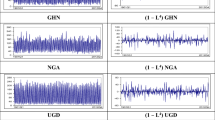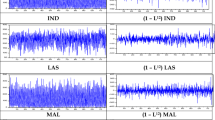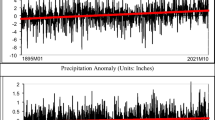Abstract
This paper evaluates the extent of climate variability in the Middle East and North Africa (MENA) region using time series structural change tests. The MENA region is highly susceptible to climate change, being one of the driest and most water-scarce regions in the world. The study aims to identify structural breaks in temperature and precipitation time series from 1901 to 2012. Specifically, a statistical analysis is performed based on a structural change model (Bai and Perron 1998, 2003a) for temperature and precipitation across 19 countries. The results indicate significant structural changes in temperature and precipitation patterns during the observation period, and suggest that climate variability has indeed begun to occur in all study area, with 1990 marking a turning point in terms of global warming. North African countries, Qatar, and the United Arab Emirates experienced a large number of breaks in temperature variables between 1901 and 2012, while other countries experienced fewer breaks. With regards to the seasonal aspect of precipitation, the individual rainfall Seasonality Index results demonstrate strong seasonal variability of rainfall from one year to another. Results show that rainfall in MENA countries is irregular throughout the year and that it ranges from seasonal to extremely seasonal throughout the study period. These findings have important implications for water resources management, agriculture, human health, and ecosystems in the region.







Similar content being viewed by others
Data availability
The authors declare that the data used in the research are available and without access restrictions.
Notes
However, we could not include Bahrain in this study due to the lack of climate data and information for this country. We focus only on the 19 countries for which climate data are available for the study period.
We have limited our study to the period 1901–2012 due to the unavailability of data for some variables (maximum and minimum temperature, temperature and precipitations anomalies as well as rainfall seasonality index) beyond this period, in another database as robust as those of the GCMon (Camarillo-Naranjo et al. 2019), notably the data come from the TS3.21 version of the CRU database (Harris et al. 2014).
While studying changes in the mean, we subdivided the period under study into four 30-year subperiods: P1= from 1901 to 1930, P2= from 1931 to 1960, P3= from 1961 to 1990 and P4= from 1991 to 2012.
We study the variation by a difference in the mean between the subperiods (P2–P1) and (P4–P3).
We define four seasons in the year: Winter (January, February, March); Spring (April, May, June); Summer (July, August, September); Fall (October, November, December).
References
Abid MA, Almazroui M, Kucharski F, O’Brien E, Yousef AE (2018) ENSO relationship to summer rainfall variability and its potential predictability over Arabian Peninsula region. NPJ Clim Atmos Sci 1(1):1–7
Abualnaja Y, Papadopoulos VP, Josey SA, Hoteit I, Kontoyiannis H, Raitsos DE (2015) Impacts of climate modes on air-sea heat exchange in the Red Sea. J Clim 28(7):2665–2681
Adarsh S, Janga Reddy M (2015) Trend analysis of rainfall in four meteorological subdivisions of southern India using nonparametric methods and discrete wavelet transforms. Int J Climatol 35(6):1107–1124
Agbazo MN, Koto N’Gobi G, Alamou E, Kounouhewa B, Afouda A (2019) Fractal analysis of the long-term memory in precipitation over bénin (West Africa). Adv Meteorol 2019
Ahmed I, Ullah A, ur Rahman MH, Ahmad B, Wajid SA, Ahmad A, Ahmed S, Hassain S (2019) Climate change impacts and adaptation strategies for agronomic crops. In Climate Change and Agriculture, pages 1–14
Almazroui M (2019) Climate extremes over the arabian peninsula using Reg CM4 for present conditions forced by several CMIP5 models. Atmosphere 10(11):675
Almazroui M (2020) Summer maximum temperature over the gulf cooperation council states in the twenty-first century: multimodel simulations overview. Arab J Geosci 13(12):1–19
Almazroui M, Hasanean H, Al-Khalaf A, Abdel Basset H (2013) Detecting climate change signals in Saudi Arabia using mean annual surface air temperatures. Theoret Appl Climatol 113:585–598
Almazroui M, Islam MN, Dambul R, Jones P (2014) Trends of temperature extremes in Saudi Arabia. Int J Climatol 34(3):808–826
Almazroui M, Saeed F, Islam MN, Alkhalaf A (2016) Assessing the robustness and uncertainties of projected changes in temperature and precipitation in AR4 Global Climate Models over the Arabian Peninsula. Atmos Res 182:163–175
AlSarmi S, Washington R (2011) Recent observed climate change over the Arabian Peninsula. Journal of Geophysical Research: Atmospheres, 116(D11)
AlSarmi SH, Washington R (2014) Changes in climate extremes in the Arabian Peninsula: analysis of daily data. Int J Climatol 34(5):1329–1345
Athar H (2014) Trends in observed extreme climate indices in Saudi Arabia during 1979–2008. Int J Climatol 34(5):1561–1574
Bai J, Perron P (1998) Estimating and testing linear models with multiple structural changes. Econometrica, pages 47–78
Bai J, Perron P (2003) Computation and analysis of multiple structural change models. J Appl Economet 18(1):1–22
Bai J, Perron P (2003) Critical values for multiple structural change tests. Economet J 6(1):72–78
Bangalath HK, Stenchikov G (2015) Role of dust direct radiative effect on the tropical rain belt over Middle East and North Africa: A high-resolution AGCM study. Journal of Geophysical Research: Atmospheres 120(10):4564–4584
Barlow M, Zaitchik B, Paz S, Black E, Evans J, Hoell A (2016) A review of drought in the Middle East and Southwest Asia. J Clim 29(23):8547–8574
Breusch T, Vahid F, et al (2011) Global temperature trends. Report provided for the Garnaut Climate Change Review. Department of Econometrics and Business Statistics Working Paper, pages 4–11
Camarillo-Naranjo JM, Álvarez-Francoso JI, Limones-Rodríguez N, Pita-López MF, Aguilar-Alba M (2019) The global climate monitor system: from climate data-handling to knowledge dissemination. International Journal of Digital Earth 12(4):394–414
Cook BI, Mankin JS, Anchukaitis KJ (2018) Climate change and drought: From past to future. Current Climate Change Reports 4(2):164–179
Dogar MM, Sato T (2018) Analysis of climate trends and leading modes of climate variability for MENA region. Journal of Geophysical Research: Atmospheres 123(23):13–074
Dogar MM, Stenchikov G, Osipov S, Wyman B, Zhao M (2017) Sensitivity of the regional climate in the Middle East and North Africa to volcanic perturbations. Journal of Geophysical Research: Atmospheres 122(15):7922–7948
Donat M, Peterson T, Brunet M, King A, Almazroui M, Kolli R, Boucherf D, Al-Mulla AY, Nour AY, Aly AA et al (2014) Changes in extreme temperature and precipitation in the arab region: long-term trends and variability related to ENSO and NAO. Int J Climatol 34(3):581–592
Driouech F (2010) Distribution des précipitations hivernales sur le Maroc dans le cadre d’un changement climatique: descente d’échelle et incertitudes. PhD thesis
Driouech F, ElRhaz K, Moufouma-Okia W, Arjdal K, Balhane S (2020) Assessing future changes of climate extreme events in the CORDEX-MENA region using regional climate model ALADIN-climate. Earth Systems and Environment 4(3):477–492
ESCWA et al. (2017). Arab Climate Change Assessment Report - Main Report. Beirut, E/ESCWA/SDPD/2017/RICCAR/Report
Fan Y, Van den Dool H (2008) A global monthly land surface air temperature analysis for 1948–present. Journal of Geophysical Research: Atmospheres, 113(D1)
Gallagher C, Lund R, Robbins M (2013) Changepoint detection in climate time series with long-term trends. J Clim 26(14):4994–5006
Gil-Alana LA, Yaya OS, Fagbamigbe AF (2019) Time series analysis of quarterly rainfall and temperature (1900–2012) in sub- Saharan African countries. Theoret Appl Climatol 137(1):61–76
Goswami BN, Venugopal V, Sengupta D, Madhusoodanan M, Xavier PK (2006) Increasing trend of extreme rain events over india in a warming environment. Science 314(5804):1442–1445
Goula BTA, Soro EG, Kouassi W, Srohourou B (2012) Tendances et ruptures au niveau des pluies journalières extrêmes en côte d’ivoire ( Afrique de l’ Ouest). Hydrological Sciences Journal 57(6):1067–1080
Hamdi R, Kusaka H, Doan Q-V, Cai P, He H, Luo G, Kuang W, Caluwaerts S, Duchêne F, Van Schaeybroek B et al (2020) The state-of-the-art of urban climate change modeling and observations. Earth Systems and Environment 4(4):631–646
Harris I, Jones PD, Osborn TJ, Lister DH (2014) Updated high-resolution grids of monthly climatic observations–the CRU TS3. 10 Dataset. International Journal of Climatology, 34(3):623–642
Harris I, Osborn TJ, Jones P, Lister D (2020) Version 4 of the CRU TS monthly high-resolution gridded multivariate climate dataset. Scientific Data 7(1):1–18
Haywood JM, Jones A, Bellouin N, Stephenson D (2013) Asymmetric forcing from stratospheric aerosols impacts Sahelian rainfall. Nat Clim Chang 3(7):660–665
Hurrell JW (1995) Decadal trends in the North Atlantic Oscillation: Regional temperatures and precipitation. Science 269(5224):676–679
IPCC (2022). Climate change 2022: Impacts, adaptation and vulnerability. Contribution of Working Group II to the Sixth Assessment Report of the Intergovernmental Panel on Climate Change [pörtner, hans-otto and roberts, debra c and adams, h and adler, c and aldunce, p and ali, e and begum, r ara and betts, r and kerr, r bezner and biesbroek, r and others]. Cambridge University Press, Cambridge
Kuglitsch FG, Toreti A, Xoplaki E, Della-Marta PM, Zerefos CS, Türkeş M, Luterbacher J (2010) Heat wave changes in the eastern Mediterranean since 1960. Geophysical Research Letters, 37(4)
Kumar KN, Ouarda TB, Sandeep S, Ajayamohan RS (2016) Wintertime precipitation variability over the Arabian Peninsula and its relationship with ENSO in the CAM4 simulations. Clim Dyn 47(7):2443–2454
Lelieveld J, Proestos Y, Hadjinicolaou P, Tanarhte M, Tyrlis E, Zittis G (2016) Strongly increasing heat extremes in the Middle East and North Africa ( MENA) in the 21st century. Clim Change 137(1):245–260
Livada I, Asimakopoulos D (2005) Individual seasonality index of rainfall regimes in Greece. Climate Res 28(2):155–161
Lubes-Niel H, Masson J, Paturel J, Servat E (1998) Variabilité climatique et statistiques. Etude par simulation de la puissance et de la robustesse de quelques tests utilisés pour vérifier l’homogénéité de chroniques. Revue des sciences de l’eau/Journal of Water Science, 11(3):383–408
Maharana P, Abdel-Lathif AY, Pattnayak KC (2018) Observed climate variability over Chad using multiple observational and reanalysis datasets. Global Planet Change 162:252–265
Merlone A, Al-Dashti H, Faisal N, Cerveny RS, AlSarmi S, Bessemoulin P, Brunet M, Driouech F, Khalatyan Y, Peterson TC, et al. (2019) Temperature extreme records: World Meteorological Organization metrological and meteorological evaluation of the 54.0 c observations in Mitribah, Kuwait and Turbat, Pakistan in 2016/2017. International Journal of Climatology, 39(13):5154–5169
Mirza M, Warrick R, Ericksen N, Kenny G (1998) Trends and persistence in precipitation in the Ganges, Brahmaputra and Meghna river basins. Hydrol Sci J 43(6):845–858
Muthuramu P, Maheswari TU et al (2019) Tests for structural breaks in time series analysis: A review of recent development. Shanlax International Journal of Economics 7(4):66–79
Ouhamdouch S, Bahir M, Ouazar D, Carreira PM, Zouari K (2019) Evaluation of climate change impact on groundwater from semi-arid environment ( Essaouira Basin, Morocco) using integrated approaches. Environmental Earth Sciences 78(15):1–14
Pandey BK, Tiwari H, Khare D (2017) Trend analysis using discrete wavelet transform (dwt) for long-term precipitation (1851–2006) over India. Hydrol Sci J 62(13):2187–2208
Priyadarshi N, Bandyopadhyay S, Chowdary V, Chandrasekar K, Chockalingam J, Raj U, Jha CS (2020) Segmentation-based approach for trend analysis and structural breaks in rainfall time series (1851–2006) over India. Hydrol Sci J 65(9):1583–1595
Ruggieri E (2013) A Bayesian approach to detecting change points in climatic records. Int J Climatol 33(2):520–528
Sandeep S, Ajayamohan R (2018) Modulation of winter precipitation dynamics over the Arabian Gulf by ENSO. Journal of Geophysical Research: Atmospheres 123(1):198–210
Seidel DJ, Lanzante JR (2004) An assessment of three alternatives to linear trends for characterizing global atmospheric temperature changes. Journal of Geophysical Research: Atmospheres, 109(D14)
Seneviratne S, Nicholls N, Easterling D, Goodess C, Kanae S, Kossin J, Luo Y, Marengo J, McInnes K, Rahimi M, et al (2012) Changes in climate extremes and their impacts on the natural physical environment
Sharma S, Singh PK (2019) Spatial trends in rainfall seasonality: a case study in Jharkhand. India. Weather 74(1):31–39
Sowers J, Vengosh A, Weinthal E (2011) Climate change, water resources, and the politics of adaptation in the Middle East and North Africa. Clim Change 104(3):599–627
Stenchikov G, Dogar M (2012) Regional climate response to volcanic radiative forcing in Middle East and North Africa. In EGU General Assembly Conference Abstracts, page 6373
Stockwell DR, Cox A (2009) Structural break models of climatic regime-shifts: claims and forecasts. arXiv preprint arXiv:0907.1650
Tabari H, Talaee PH (2011) Temporal variability of precipitation over Iran: 1966–2005. J Hydrol 396(3–4):313–320
Tanarhte M, Hadjinicolaou P, Lelieveld J (2012) Intercomparison of temperature and precipitation data sets based on observations in the Mediterranean and the Middle East. Journal of Geophysical Research: Atmospheres, 117(D12)
Tomé AR, Miranda P (2005) Continuous partial trends and low-frequency oscillations of time series. Nonlinear Process Geophys 12(4):451–460
United Nations, D (2013) World Population Prospects: The 2012 Revision. New York, NY, USA, United Nations Department of Economic and Social Affairs, Population Division
Waha K, Krummenauer L, Adams S, Aich V, Baarsch F, Coumou D, Fader M, Hoff H, Jobbins G, Marcus R et al (2017) Climate change impacts in the Middle East and Northern Africa ( MENA) region and their implications for vulnerable population groups. Reg Environ Change 17(6):1623–1638
Walsh R, Lawler D (1981) Rainfall seasonality: description, spatial patterns and change through time. Weather 36(7):201–208
Werner R, Valev D, Danov D, Guineva V (2015) Study of structural break points in global and hemispheric temperature series by piecewise regression. Adv Space Res 56(11):2323–2334
World Bank (2014). Turn down the heat: confronting the new climate normal. World Bank Publications
World Bank (2016). High and dry: Climate change, water, and the economy. World Bank Publications
World Bank (2017). Beyond Scarcity: Water Security in the Middle East and North Africa. The World Bank Publications
World Bank (2018). Indicateurs du développement dans le monde. Washington,DC 20433
Yobom O (2020) Climate change and variability: empirical evidence for countries and agroecological zones of the Sahel. Climatic Change, pages 1–20
Zarenistanak M, Dhorde AG, Kripalani R (2014) Trend analysis and change point detection of annual and seasonal precipitation and temperature series over southwest Iran. J Earth Syst Sci 123(2):281–295
Zhang X, Aguilar E, Sensoy S, Melkonyan H, Tagiyeva U, Ahmed N, Kutaladze N, Rahimzadeh F, Taghipour A, Hantosh T, et al. (2005) Trends in Middle East climate extreme indices from 1950 to 2003. Journal of Geophysical Research: Atmospheres, 110(D22)
Ziese M, Becker A, Finger P, Meyer-Christoffer A, Rudolf B, Schneider U (2011) GPCCFirst Guess Product at 1.0: Near real-time first guess monthly land-surface precipitation from rain-gauges based on SYNOPdata
Funding
Raja Chakir acknowledges financial support from the Agence Nationale de la Recherche as part of Cland Institut de convergence (ANR-16-CONV-0003).
Author information
Authors and Affiliations
Corresponding author
Ethics declarations
Conflict of interest
The authors state that there is no conflict of interest.
Appendices
Appendix: Tables
B Appendix: Figures
See Figs. 8, 9, 10, 11, 12, 13, 14, 15, 16, 17, 18, 19, 20, 21.
Rights and permissions
Springer Nature or its licensor (e.g. a society or other partner) holds exclusive rights to this article under a publishing agreement with the author(s) or other rightsholder(s); author self-archiving of the accepted manuscript version of this article is solely governed by the terms of such publishing agreement and applicable law.
About this article
Cite this article
Amouzay, H., Chakir, R., Dabo-Niang, S. et al. Structural Changes in Temperature and Precipitation in MENA Countries. Earth Syst Environ 7, 359–380 (2023). https://doi.org/10.1007/s41748-023-00344-2
Received:
Revised:
Accepted:
Published:
Issue Date:
DOI: https://doi.org/10.1007/s41748-023-00344-2


















